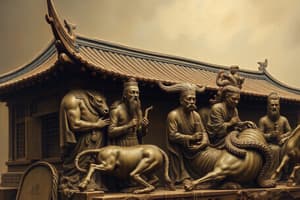Podcast
Questions and Answers
What did mountains represent in Chinese landscape paintings?
What did mountains represent in Chinese landscape paintings?
- Fluidity and adaptability
- Strength and rigidity (correct)
- Instability and change
- Softness and movement
What was the purpose of including human figures in these landscapes?
What was the purpose of including human figures in these landscapes?
- To provide a sense of scale and illustrate the relationship between humans and their environment (correct)
- To showcase the vastness of the landscape
- To highlight the spiritual and contemplative aspects of nature
- To depict the rural activities of the people
What was the focus of literati painting (wenren hua)?
What was the focus of literati painting (wenren hua)?
- Technical skill and traditional techniques
- Personal expression over technical skill (correct)
- Realistic depiction of nature
- Detailed and complex compositions
What was a notable development in Chinese landscape painting during the Southern Song dynasty?
What was a notable development in Chinese landscape painting during the Southern Song dynasty?
What did Chinese landscape paintings from the Song period reflect about the values and beliefs of Chinese society?
What did Chinese landscape paintings from the Song period reflect about the values and beliefs of Chinese society?
Study Notes
Chinese Landscape Paintings during the Song Period
During the Song period (960-1279 AD), China experienced a significant shift in its artistic traditions. One of the most notable changes was in the realm of landscape painting. This type of art was characterized by its emphasis on capturing the essence of nature rather than simply reproducing realistic images. Chinese landscape paintings from the Song period are notable for their abstract interpretation of natural elements and their exploration of human relationships with the environment.
Techniques and Media
Artists of the Song period primarily used ink and watercolors, often layering multiple colors to achieve depth and texture. Their materials of choice were silk or paper. Silk was preferred due to its durability and ability to support many layers of paint. Paper, though less common for large works, was used for smaller pieces and handscrolls.
Subjects and Inspiration
Subjects in Song landscape paintings ranged from mountains, rivers, and forests to imagined landscapes and scenes inspired by poetry. Artists in this period often drew inspiration from classical texts and literature, particularly the themes of withdrawal into nature and the pursuit of spiritual peace and harmony.
Mountains and Water
The contrast between hard mountainous landscapes and fluid waterways was a common motif in Song landscape paintings. This duality reflected the philosophical concepts of yin and yang, with mountains representing stability and rigidity while water symbolized softness and movement. These opposites were seen as complementary forces that existed within nature and society.
Human Interaction with Nature
In addition to natural elements, human figures often appeared in these landscapes. They served not only to provide scale but also to illustrate the relationship between humans and their environment. Sometimes, they were placed in contemplative positions, emphasizing introspection and spiritual contemplation. Other times, they engaged in activities like fishing or hunting, highlighting the practical aspects of rural life.
The Evolution of Landscape Painting
Over time, Chinese landscape painting evolved into various styles and schools. One notable development was the emergence of literati painting (wenren hua), which focused on personal expression over technical skill. During the Southern Song dynasty, there was a trend towards simplified compositions and a focus on individual style rather than strict adherence to traditional techniques.
This period saw the beginning of experimentation with new artistic approaches, such as expressive brushwork and a preference for flattened space. These innovations would continue to influence Chinese art throughout subsequent dynasties, including the Yuan, Ming, and Qing periods.
Cultural Significance
Chinese landscape paintings from the Song period offer insights into the values and beliefs of Chinese society during this time. Their emphasis on harmony between nature and humanity reflects broader cultural trends, particularly the importance of self-cultivation and withdrawal into the natural world for spiritual renewal. These paintings also served as markers of social status, with many collected and displayed by scholars and officials as symbols of refinement and education.
In conclusion, Chinese landscape paintings during the Song period represent a significant chapter in the history of East Asian art. They showcase not only technical mastery but also philosophical insights and cultural values that continue to resonate today. Through their depictions of nature and human interaction with it, these works offer enduring testament to the rich artistic legacy of ancient China.
Studying That Suits You
Use AI to generate personalized quizzes and flashcards to suit your learning preferences.
Description
Explore the artistic traditions and cultural significance of Chinese landscape paintings during the Song period (960-1279 AD). Learn about the techniques, subjects, and evolution of landscape painting in this transformative era of Chinese art history.




